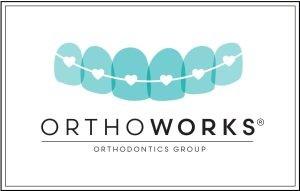Candy and pumpkin spice season has arrived! So for October’s orthodontic “Did you know” we are highlighting how orthodontic treatment impacts oral health, specifically your risk for cavities and gum disease.
To understand how braces and Invisalign can affect your teeth, we must first understand how cavities and gum disease happen.
To start, what are teeth and gums? Teeth are the hard things in your mouth that help you to chew and what people see when you smile. Gums are the pink “skin” that covers the tooth.
Teeth are made up of 3 layers: An outer layer of enamel, a middle layer of dentin, and an inner layer of pulp.
Enamel and dentin are made up of minerals, which is what gives them hardness. Enamel is stronger than dentin, so it is the outer layer that protects the tooth. When your dentist tells you that you have a cavity, it means that bacteria have been feasting on the food-filled plaque on the teeth. Once they finish feasting they excrete acid which dissolves your enamel. Initially, this softened enamel can appear white and chalky in color- this is called a “white spot lesion” and is what your dentist may refer to as a “scar” or “pre-cavity”.
Over time the acid weakens the enamel so much that it becomes a hole that the bacteria invade, digging deeper and deeper into the tooth. If left untreated, they eventually eat their way to the pulp (where the nerve and blood supply live), causing tooth pain. That same food-filled plaque that bacteria feast on can also irritate the gums.
Think of that plaque as dirt on your skin. The longer you leave the dirt, your skin becomes itchy and red.
This is called an inflammatory reaction. When it happens to the gum, dentists call it gingivitis. This is a reversible disease. But because inflamed gums tend to bleed very easily and may be tender when you brush, you may not feel inclined to brush as much. If the plaque is not removed properly the inflammation can worsen and eventually start to erode the bone underneath the gums and around the teeth, causing periodontitis. This is an irreversible disease – once bone is lost it is very difficult, sometimes impossible, to grow back.

So why is it important then to first understand what cavities and gum disease are and how they happen before you start your orthodontic treatment?
Both are caused by poor brushing, which leaves plaque on the teeth. When we do orthodontic treatment, we are placing more obstacles on the teeth that make it harder to brush. Thus, if you do not take extra good care of your teeth during the treatment, it can be easier to get white spots, cavities, and gum disease. Even after braces come off, those spots and lesions will remain and require treatment with your dentist, which can put a damper on the excitement of getting braces off.
But don’t fear!
Getting into a good oral hygiene routine before you start orthodontics can set you up for success! To help you see the spots you are missing, buy a plaque-disclosing tablet which will color stain the problem areas. Then focus first on your brushing technique. Spend 2-3 minutes brushing all the teeth, making sure to be gentle but thorough. Once you feel confident with your brushing, add in flossing! This can be a tricky skill to learn, so start with floss picks or a water flosser before you try the string floss. Practice makes perfect! What you use to clean your mouth is also important.
Dr. Fang’s recommendation for the perfect mouth-cleaning toolkit is:
- Electric toothbrush or soft bristle regular toothbrush
- Toothpaste that contains fluoride
- Mouthwash that contains fluoride
- Tongue scraper
- Floss
- Plaque disclosing tablets
The American Dental Association has a great page discussing brushing techniques and flossing, so go check it out!
Happy brushing!
Comment below or email info@sanfranciscomoms.com with your questions for the orthodontist to be addressed in future articles! If you think you or your child is ready to think about braces and teeth alignments, visit orthoworks.com and schedule a virtual consultation. Summer Promotion: Complementary orthodontic consultation for children aged 6 to 18!
 WENDY FANG, DDS, MPH
WENDY FANG, DDS, MPH
Dr. Fang is a graduate of Stony Brook University, where she received her Bachelor of Science degree in Biology, Doctorate of Dental Surgery (DDS), and Masters in Public Health (MPH). Following dental school, she went on to earn her Certificate in Orthodontics at Montefiore Medical Center in The Bronx, NY where she was appointed Chief Resident in her third year. Dr. Fang’s dedication to continuing education and passion for dentistry is what allow her to provide an excellent standard of care to patients of all ages. She is a member of the American Association of Orthodontists and the Pacific Coast Society of Orthodontists and is ABO board-certified.
 About Orthoworks Invisalign and Orthodontics Group
About Orthoworks Invisalign and Orthodontics Group
OrthoWorks Invisalign and Orthodontics Group is the #1 Provider of Invisalign treatments in the San Francisco Bay Area and was founded by Dr. David Shen, who is recognized as one of the top five most experienced Invisalign® doctors in the world and is a member of the Top 1% Elite Provider Club. Dr. Shen and Associates specialize in providing orthodontic care using a variety of techniques including Invisalign® appliances, traditional braces, surgical orthodontics, cleft palate/cleft lips, and sleep apnea. In short, their practice is dedicated to one goal: to create healthy and beautiful smiles for children and adults using the highest quality of orthodontic care available. To achieve this, Orthoworks utilizes the latest technological advancements in the field together with the team’s collective experiences. Over the years, the practice has grown from its original three locations to over ten locations throughout the San Francisco Bay Area, serving over 60,000 orthodontic patients.





















